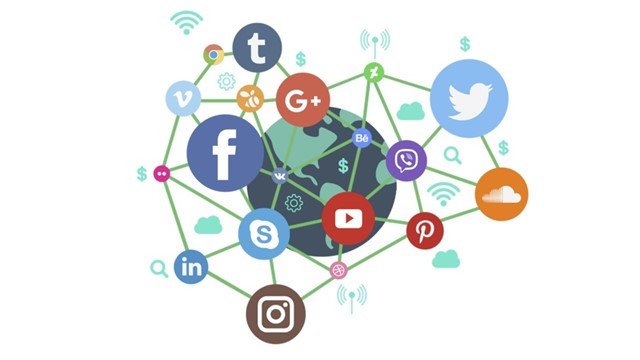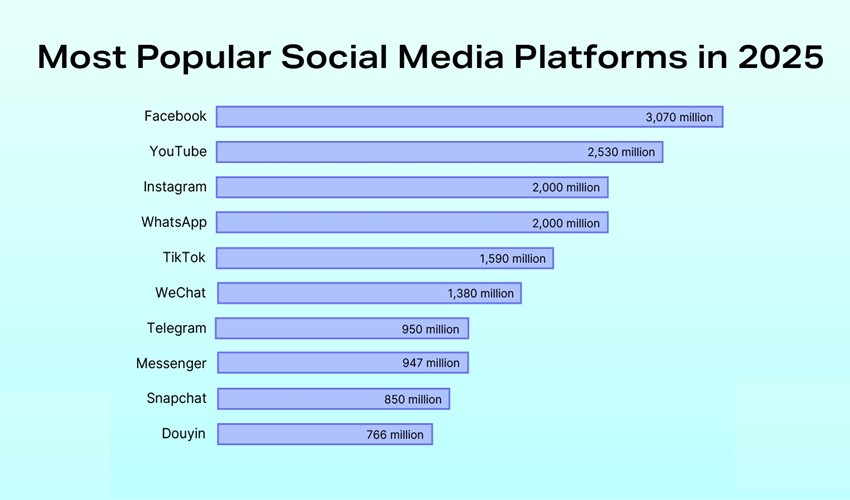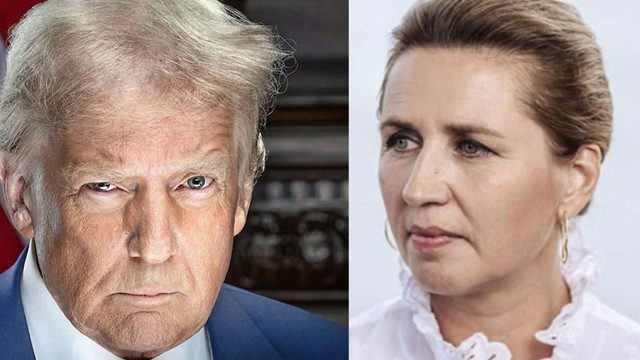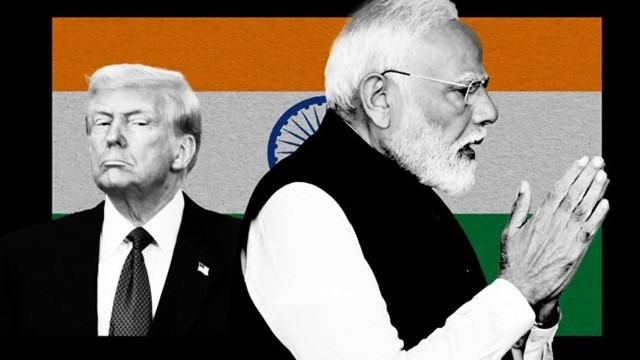২৪ পৌষ ১৪৩২
Top 10 Most Used Social Media Platforms by 2025
07 July 2025 17:07 PM
NEWS DESK
Social media can increase brand awareness and drive visitors to your website, if you know where your audience spends their time. Knowing which platforms your brand’s target audience uses most helps you focus your social media marketing strategy to build meaningful connections.
Read on to learn about the most popular social media platforms and the unique strengths they offer brands. Facebook- 3,070 million, YouTube- 2,530 million, Instagram- 2,000 million, WhatsApp- 2,000 million, 5.TikTok- 1,590 million, WeChat- 1,380 million, Telegram- 950 million, Messenger- 947 million, Snapchat- 850 million and Douyin- 766 million.
These are the 10 most-used social media platforms worldwide. Facebook continues to lead globally, followed by YouTube and Instagram.
1. Facebook (3.07 billion users)
With nearly 3.1 billion users worldwide, it’s no surprise that Facebook is the most popular social media platform. That means that nearly three out of every five of the estimated 5.24 billion social media users across the world are active on Facebook. Facebook remains dominant due to its vast reach and diverse audience. In the United States, the biggest share of Facebook users is 25- to 34-year-olds, at 24.2%, followed by 35- to 44-year-olds at 19%. This app’s vast audience makes it essential for brands seeking maximum exposure on top social media apps.
Image posts are the most engaging posts on the platform, giving ecommerce businesses an opportunity to familiarize their audiences with their products. Take Fenty Beauty, for example. On its Facebook page, the beauty brand often shares static images so followers can learn about its product range.
2. YouTube (2.53 billion users)
Launched in 2005, YouTube is a video content powerhouse. As of November 2024, users spent more than 27 hours monthly on the mobile app. YouTube excels at supporting long-form videos, which are ideal for educating audiences about your products or services. Take Luxy Hair: The brand grew its YouTube audience through educational content, such as tutorials showing viewers how to wear its hair extensions and keep hair healthy.
3. Instagram (2 billion users)
Instagram’s emphasis on visual storytelling makes it a go-to platform for brands and influencers connecting with the 18 to 34 crowd- its largest US demographic. While carousels and single-image grid posts saw a decrease in engagement from 2023 to 2024, Reels- the platform’s short form video format- saw a 45% increase in the same time frame. Instagram Reels can help you explain your products, increase organic reach, and build your brand. For example, you can demonstrate how your product solves problems for potential customers. Take Bombas, which shared a short video illustrating how its gripper socks could help a standing pilates workout.
4. WhatsApp (2 billion users)
Known for personal messaging, voice, and video calls, WhatsApp is also a rising business communications platform. In Brazil, for example, nearly four out of five WhatsApp users reported communicating with a brand through the platform. WhatsApp’s conversational aspect makes it especially effective for customer support and marketing campaigns.
5. TikTok (1.59 billion users)
Short form video has never been more addictive or profitable for brands tapping into youth culture. TikTok has captured the attention of 18- to 34-year-olds (its largest demographic) with its swipeable videos and a For You page that surfaces new, relevant content. Since launching TikTok Shop in 2023, the app has opened up new direct selling opportunities for entrepreneurs targeting a younger audience.

6. WeChat (1.38 billion users)
In China, one app rules them all, combining social networking, instant messaging, payments and ecommerce: WeChat. Global brands targeting Chinese customers can set up a WeChat store within the platform. Ecommerce is central to WeChat- 61% of WeChat Channel users have made a purchase, and 87% say they’ll shop there again. With built-in marketing tools and direct messaging, WeChat offers brands a way to reach customers.
7. Telegram (950 million users)
Telegram is a social media and communication platform. It’s popular for personal and group communications, and for broadcasting messages to large audiences. Telegram is more than a messaging app; ecommerce stores can send push messages to customers, set up customer service chat functions, and sell physical and digital products directly via mini-apps and bots. The countries with the top in-app purchases in 2024 were Russia ($27.6 million), the US ($23.6 million), and Ukraine ($12 million). These figures highlight Telegram’s growing role as a monetized platform for messaging, ecommerce, and paid content.
8. Messenger (947 million users)
Messenger, formerly known as Facebook Messenger, is a messaging platform used for personal conversations. Since Meta owns it, brands can tap into one of the most popular social media ecosystems. In the US, Messenger leads among 25- to 34-year-olds, who make up 23% of its user base, followed by 35- to 44-year-olds, who make up 21%. Brands can use Messenger to talk to customers through chatbots or live customer service, or to sell products and accept payments.
9. Snapchat (850 million users)
Temporary content format and addictive AR filters make Snapchat ideal for brands targeting younger, mobile-first users. If your audience is under 25, Snapchat offers big moneymaking potential, from influencer partnerships to Snapchat Discover content to Snapchat ads.
10. Douyin (766 million users)
Douyin, the Chinese version of TikTok, mirrors TikTok’s features- such as integrations with ecommerce and payment systems- but is tailored to China’s large social commerce market. Ecommerce brands can create short- and long-form content to connect with audiences, livestream to introduce viewers to products, and set up a Douyin shop.



















Comments Here: